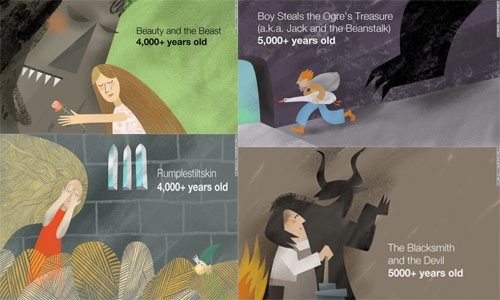Some fairy tales go back thousands of years
Read "Jack and the Beanstalk" to your kids this evening, and you are probably putting them in touch with human sentiments that are thousands of years old.
Same goes if you read them "Beauty and the Beast," or maybe "Rumpelstiltskin."
A new study has found that classic fairy tales may be "much older than previously believed," one of the authors, Jamshid Tehrani of the UK's Durham University, said Wednesday. Tehrani wrote the study with Sara Graca da Silva of the New University of Lisbon, in Portugal.
The dating of fairy tales has long been the subject of spirited debate. Wilhelm Grimm -- who together with his brother, Jacob, popularized in the 19th century many fairy tales that remain favorites today -- believed many were probably thousands of years old. But often they were transmitted only orally, which makes tracking their emergence difficult.
Stories that speak to 'enduring human concerns'
Because of that, the authors of the study said, "only a tiny minority can be tracked to before the emergence of the literary fairy tale in the 16th and 17th Centuries."
"This has led to intense debates about the presumed antiquity of traditional tales, with some researchers claiming that many canonical fair tales may actually be relatively recent literary inventions," the study says.
But the study, using the science of linguistic groups and dispersion, has concluded that some stories -- "The Smith and the Devil," for example, in which a blacksmith makes a deal with the devil to gain supernatural powers -- are 5,000 to 6,000 old, Tehrani said in an email to CNN. The same may be true for "Jack and the Beanstalk," he said.
"Rumpelstiltskin" and "Beauty and the Beast" are also very old, Tehrani told Sky News.
The folk tales that endure through the millennia are those that "speak to enduing human concerns," Tehrani said. Family relationships, including obligations and conflict, are a recurrent theme, he said.
Pruning the trees to 'remove taxa'
The study, as you would expect, is an academic treatise, and it does not read quite as easily as "Beauty and the Beast."
The section headings include topics such as "Testing for phylogenetic signal" and "Autologistic analyses."
After explaining that the study relied on "language trees," it goes on to say, "Next, we pruned the trees to remove taxa for which there was no corresponding folktale corpus except Hittite ... " and the sentence continues from there.
So if you are choosing something to read to your daughter this evening, you might want to consider "Jack and the Beanstalk" over the somewhat more difficult "Comparative phylogenetic analyses uncover the ancient roots of Indo-European folktales."
Unless, of course, you really want to put her to sleep.
Related Posts

